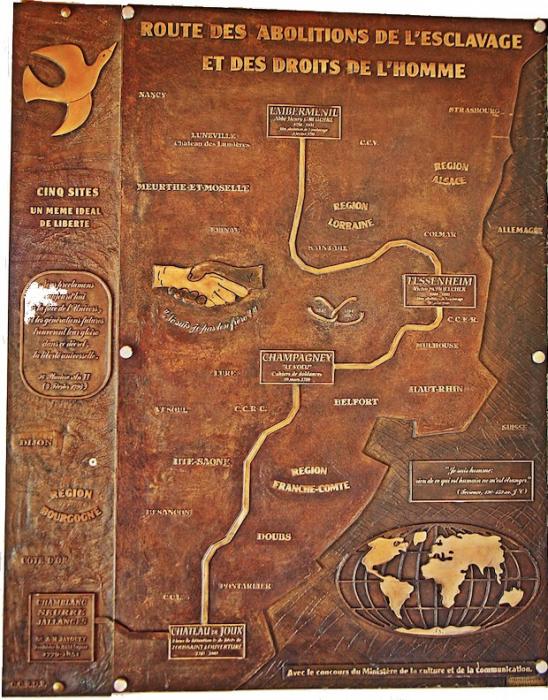“National and European memory centre of the Great East of France, 25 high places of history and memories of the abolition of slavery (1648-1848)”
The territory of Eastern France, including the regions of Burgundy Franche-Comté, Alsace-Lorraine and Champagne Ardenne, has historically been the cradle of the movement for the abolition of black slavery, the first form of globalization in history. In 4 centuries, this economic system has crushed in colonial industry between 12 and 15 million Africans with considerable repercussions in the human, economic, social and cultural history of three continents.
Since 1994, this tragedy in world history has been at the heart of an international mobilization at UNESCO’s request, supported by the recommendations of the United Nations. The objective is to develop knowledge of this page of world history, to enhance its memory while raising awareness of its consequences in the modern societies.
In this momentum of openness, France was the first country to adopt a memorial law in 2001 to recognize slavery as a crime against humanity.
At the national and European level, and even internationally, the commitment to memory in our regions was precursor and initiated in 1901 at the Fort de Joux, joined in the 1970s by the sites of Champagney, Chamblanc, Fessenheim and Emberménil, which, since 1998, have been structured and organized in the project of the Road of Abolitions of Slavery, the first network of sites and places of memory created in the world. This network became an association under the 1901 law in 2004. Since 2015, it has been recognized as being of general interest.
This pioneering initiative has enabled the network of the Road of Abolitions and the territory of Eastern France, not only to precede national and international memorial commitments, but also to be present at the major memorial and commemorative events of the period 1998-2004, to receive numerous supports and sponsorship at the highest levels of the State, to develop promotion and media coverage actions and to increase the number of visits by personalities and interventions at national and international levels.
To strengthen the attractiveness of this territory of Eastern France, develop a strong historical image around the defence of freedoms and respond to the challenges of raising awareness and enable the implementation of educational actions around the issues of racism, xenophobia and forms of intolerance, the Road of Abolitions network is committed to developing a new strategy and implementing new actions with two main objectives: |
 |
- to position Eastern France and Switzerland as a major national and European memory centre by uniting the 20 other sites and places of memory identified in the territory around the network of the 5 sites of the Road of Abolitions of slavery.
- to develop remembrance tourism around the discovery of the history of slavery and its abolition through a diversified offer (castles, museums, monuments and memorials,…) and scattered with famous figures (Alphonse de Lamartine, Victor Schœlcher, Toussaint Louverture, Victor Hugo, the Abbé Grégoire, Germaine de Staël,….) by attracting new audiences (national and international diaspora of descendants of slaves, schools, various personalities, local populations and tourism for stay and passage…
The ambition of the national memory centre in the Great East region is based on the experience and networks already developed by the sites of the Road of Abolitions in conjunction with support from local authorities (municipalities that own the memory sites and departmental and regional councils to support investment actions in the sites and promotion of the network).
The creation of this great national and European memory centre, which thus places this geographical area in a unique and monopoly position on the history and memory of the abolition of slavery and the struggle for freedom, is part of the new memory challenges promoted by national and international organisations and meets the expectations of audiences and tour operators
The national memory centre of the Great East region:
The memory centre of the Great East region offers you a complete discovery of the stages and characters who participated in the long process of the history of the abolition of slavery through more than 25 symbolic high place
The first convictions of slavery (1650-1740):
Century of Enlightenment and development of convictions (1748 - 1789):
The French Revolution and the 1st abolition of slavery (1789 - 1794):
The The insurrection of Santo Domingo and the re-establishment of slavery (1791 - 1802):
The resumption of the struggle for the abolition of slavery (1815-1848)
The definitive abolition of slavery in 1848 and the integration of former slaves (1848 -…)
|
 |









